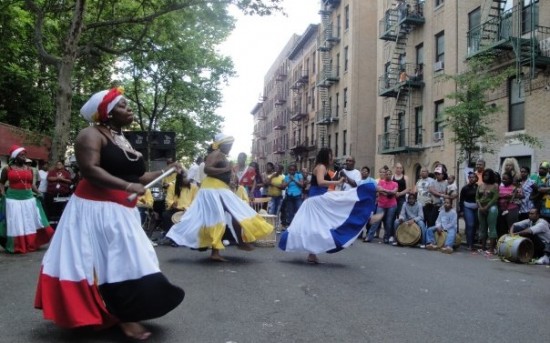
Proud of their heritage, Garifunas keep their culture alive
Casa Yurumein is a house that looks like a home. The walls of its living room are covered with friendly family pictures. But though the people in the sepia photos bear a family resemblance, they are not mothers and fathers, aunts and uncles, siblings and cousins.
Instead, the people who frequent Casa Yurumein are related by heritage.
The house on Fulton Avenue between 167th and 168th streets is a center for Garifunas–descendants of a particular group of Caribbean people, who have preserved their own language and developed their own culture for centuries.
Born of the union of slaves who became free when the ships carrying them from Africa were wrecked and who then intermarried with the natives of Central America, the Garifunas originally settled on St. Vincent (Yurumein is the Garifuna name for the island), then spread to other Central American nations.
Garifuna society is unique: although the Garifunas are descended from slaves, they were born free.
Casa Yurumein’s mission is to pass on the Garifuna culture to those who live in the New York area, where the pressures of assimilation are strong. The center offers courses in Garifuna language, history, art, Garifuna spirituality, cooking, and needlework. It seeks to help these expatriates to “own their roots,” said Mirtha Colon, the organization’s director.
Although Garifunas live in all five boroughs and New Jersey, the largest community outside Central America is in the Bronx, according to the Garifuna Coalition USA, a Mott Haven-based organization with headquarters on E. 149 Street.
The coalition, which is dedicated to cross-cultural understanding of Garifuna culture, estimates that more than 100,000 Garifunas live in the metropolitian area.
“Garifunas were fishermen, so it’s logical that when we migrated we looked for ports,” Arturo Martinez, the secretary of Casa Yuremein’s youth group, explained.
Casa Yuremein opened its doors in November, 2008. “We work reaching many, one by one,” said Martinez.
Jackie Palacios 22, who was crowned Miss Garifuna last April, provides an example. “I learned that drums have many names, I learned the difference in all the Garifuna dances, the history of where Garifunas came from, how they were in ships for 30 days, how our leaders fought for us. I learned the language, and that our background is African, Carib, and Arab,” she said.
Among the teachers are long-time New Yorkers who learned their own lessons in taking pride in their heritage.
Art teacher Rene Moreira arrived in the U.S. from Honduras 29 years ago at age 15. “I learned to say, ‘I am Garifuna.’ I learned the value of being from St. Vincent. Before I would say I am from Honduras. I would give any type of description except that one,” she said. Now, she declares, “I have black roots and I am a black Garifuna.”
She finds the same lesson resonates with young people. “Four years ago I had three students. Today I have groups of up to 18 at a time,” she said. Some are as young as 5 years old. They learn drawing, ceramics and painting by making typical Garifuna masks, which are displayed all over Casa Yuremein.
Dona Tola has been in the United States even longer than Moreira. She emigrated in the 1970s when she was 17. Now, she explains, she is a “Buyei– a person who maintains the mysticism of a tradition.” At Casa Yuremein she is in charge of the spirituality workshops and events.
“I am here because I give myself to my community and I want our children to be able to identify and know themselves, because your culture defines you as a human being,” she says.
Inside the Fulton Street house, flowered plastic tablecloths, typical of many Latin American homes, cover the kitchen and dining room tables. The tables can be used both by those who attend classes and to prepare “barbacoa” (a beef dish with garlic and seasonings) and “machucada” (a typical banana puree used as a dip to eat with fish soup). To help sustain it, the community center sells the food.
“No one works here for a salary. Everyone is a volunteer, and we work with the donations of our community,” says Colon.
The house is filled with pictures of present and past events, in the South Bronx and throughout Latin America. Their distance from their homeland hasn’t stopped the New York Garifunas from dealing with issues in Central America, where they regularly create workshops linking homeland and diaspora.
Still, the ongoing work in Casa Yurumein is to educate those who are here. As Arturo Martinez says: “We are not only a Garifuna face: we are culture, food, art, language. How am I going to go to the outside world and show them my community if I don’t know those basic things?”
A version of this article appeared in the Fall 2009 issue of the Mott Haven Herald.

Your story on the Garifunas heritage and their legacy through Casa Yurumein was very interesting. It shows to prove that you really can learn something new every day, as I did after reading your story.
By the way, is there some way that I can get a hard copy of the Mott Haven Herald? I am a graduate student in Hunter College and working on a community assessment of the Mott Haven section of the Bronx, and your newspaper would be a fantastic way of learning about the community.
Any help you could provide me would be invaluable..
I can be reached at perezegirl@aol.com or 646-359-6773.
Thank you.
Thank you for the feedback. Of course you can have a copy of the paper, our new issue will be out very soon, there are always copies in “Nos Quedamos” in Mott Haven, as well as the library, if you can’t find any feel free to let us know.